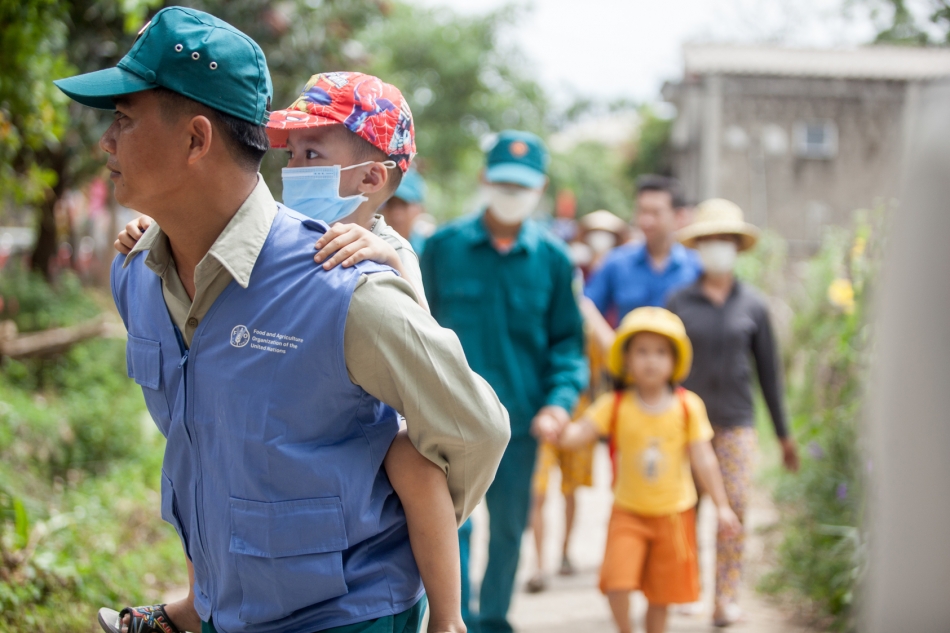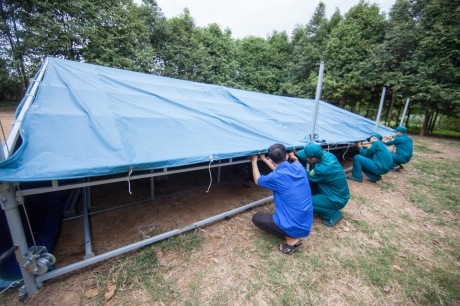
The anticipatory action plan was simulated weeks before the typhoon to better prepare for a potential activation. ©FAO/ Nguyen Minh Duc
On September 24, 2022, the Category 1 typhoon Noru, ripped through Da Nang and three other provinces of Vietnam, tearing roofs off of houses, destroying fields, harming and even killing people and livestock.
And yet, the impact could have been much worse.
As Hoang Thi Thuan, a 59-year-old from the Quang Tri province who fell victim to the typhoon’s wrath, later put it: “I had a means of ensuring we were not only safe, but we could eat and buy some extras.”
At first, there didn’t seem to be much reason for concern. By the end of it, the trail of destruction had left few homes, crops and livestock unscathed.
Nguyen Hue, an 84-year-old farmer, recalls: “When the first warnings came through over the loudspeakers, we went to take shelter nearby in a neighbour’s stronger house with a second storey. We only have a one-storey house here, and it is weak. We sat through the night hearing the strong winds blow through.”
Typhoon Noru unfolds
The European Centre for Medium-Range Weather Forecasts (ECMWF) first issued alerts of a possible tropical storm on 22 September, six days before expected landfall on Vietnam’s Quang Binh province.
The Food and Agriculture Organization of the United Nations (FAO) and the Vietnam Disaster Management Authority (VDMA) decided to closely monitor how the situation might evolve.
Sure enough, by noon of the next day, the ECMWF had upgraded its forecast to a potential typhoon hitting the central provinces in the coming days.
Communities in these provinces are no strangers to typhoons. But while they have shown remarkable resilience in the face of these recurring and increasingly extreme weather shocks, they are struggling to cope in recent years, owing in part to the impact of a global pandemic and the ensuing economic crises.
On Saturday, September 24, wind speeds were forecast to pass the trigger threshold of 90 kilometres per hour, and the typhoon was officially named Noru.
That’s when FAO’s anticipatory actions kicked in. Within 48 hours, actions were implemented in the six communes closest to the predicted landfall of Typhoon Noru.

The essential ingredient of anticipatory action is consultation with local communities and governments, as they can articulate their own concerns and identify appropriate responses and solutions.
Such consultations were conducted well in advance in Vietnam. They started with officials at both national and provincial levels and were followed up with a series of meetings at the community level involving nearly 400 participants. A set of anticipatory actions determined through the consultations was also simulated in Quang Tri province in August 2022 to better prepare for potential activation.
With funding made available by the Directorate-General for European Civil Protection and Humanitarian Aid Operations (ECHO) and with on-the-ground support from the local government and community leaders, FAO distributed 600 watertight drums, provided multi-purpose cash transfers and enacted an early warning communication plan that spanned television, loudspeaker, radio and messaging applications.
Three days prior to Typhoon Noru making landfall, Hoang Thi Do describes receiving warnings through the loudspeaker with information about what to do. “I had enough time to prepare before it [the typhoon] came. I knew it was coming.”
Like in past years during such extreme weather events, she quickly packed some personal belongings and essential items, like food, clothes and drinking water, into the watertight drums and moved with her mother to the upper floor of her house.
Hoang Thi Do states that the support given ahead of Noru allowed her to “stay dry and well fed.”
Cash payments were also hugely beneficial to the communities, offering the greatest flexibility on how to best protect themselves and their families. The cash was primarily used to buy food, as well as medicines and materials to strengthen their homes ahead of the storm.
Le Thi Vi, an 84-year-old farmer, said of the cash: “We went straight to the store and bought meat, fish cans and some milk and stored it in our new drum. We were able to keep eating healthy throughout the event, and we felt confident we would be okay in the aftermath when roads and markets are hard to reach.”
Typhoon Noru made landfall at 1:00 a.m. on 28 September, between Da Nang and Quang Nam province, with wind speeds of up to 155 kilometres per hour and more than 429 millimetres of rain in some areas.

The result was over 7,000 damaged or collapsed houses. It also decimated over 5,000 hectares of farmland and over 3,000 hectares of aquaculture. Almost 2,000 cattle and over 20,000 poultry were lost. Several people were killed and over 60 were injured. In addition, the typhoon caused significant damage to infrastructure, dams and irrigation systems.
Despite the typhoon’s impact, the anticipatory action taken still prevented a much worse scenario.
That’s in no small part due to the anticipatory action that FAO rolled out before Typhoon Noru struck. FAO said it hopes that the success of the preventative measures ahead of disasters like Typhoon Noru will help promote a shift in policy and a full integration of anticipatory action into the national disaster management plans of Vietnam and other countries worldwide.
Source: the FAO News and Media office, Rome
– global bihari bureau





